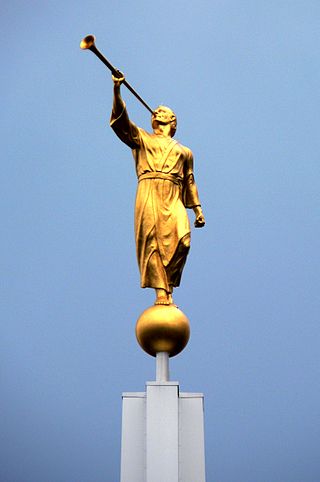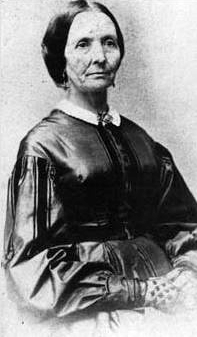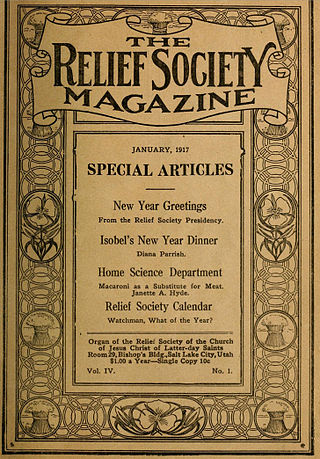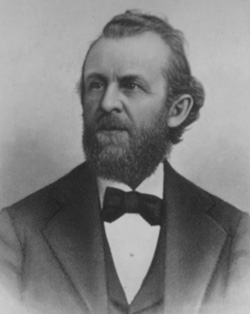
The Angel Moroni is an angel whom Joseph Smith, founder of the Latter Day Saint movement, reported as having visited him on numerous occasions, beginning on September 21, 1823. According to Smith, the angel Moroni was the guardian of the golden plates buried near his home in western New York, which Latter Day Saints believe were the source of the Book of Mormon. An important figure in the theology of the Latter Day Saint movement, Moroni is featured prominently in its architecture and art. Besides Smith, the Three Witnesses and several other witnesses also reported that they saw Moroni in visions in 1829.

Eliza Roxey Snow was one of the most celebrated Latter Day Saint women of the nineteenth century. A renowned poet, she chronicled history, celebrated nature and relationships, and expounded scripture and doctrine. Snow was married to Joseph Smith as a plural wife and was openly a plural wife of Brigham Young after Smith's death. Snow was the second general president of the Relief Society of the Church of Jesus Christ of Latter-day Saints, which she reestablished in the Utah Territory in 1866. She was also the older sister of Lorenzo Snow, the church's fifth president.

Relief Society Magazine was the official publication of the Relief Society of the Church of Jesus Christ of Latter-day Saints from 1915 to 1970. It succeeded the earlier and privately owned Woman's Exponent, which was begun in 1872. The magazine was an important publishing outlet for Utah women, and was run by women editors. The founding editor, Susa Young Gates, edited the magazine from 1915 to 1922. The December 1970 issue of the Relief Society Magazine was its last. The LDS Church discontinued the magazine as part of the implementation of the Priesthood Correlation Program. Thus, the magazine and several others within the church were replaced by the Ensign.
William Harrison Folsom was an architect and contractor. He constructed many of the historic buildings in Utah, particularly in Salt Lake City. Many of his most prominent works were commissioned by the Church of Jesus Christ of Latter-day Saints. For a time he was sustained as the Church Architect, a calling in the church.

The Mormon pioneers were members of the Church of Jesus Christ of Latter-day Saints, also known as Latter-day Saints, who migrated beginning in the mid-1840s until the late-1860s across the United States from the Midwest to the Salt Lake Valley in what is today the U.S. state of Utah. At the time of the planning of the exodus in 1846, the territory comprising present-day Utah was part of the Republic of Mexico, with which the U.S. soon went to war over a border dispute left unresolved after the annexation of Texas. The Salt Lake Valley became American territory as a result of the Treaty of Guadalupe Hidalgo, which ended the war.

William Samuel Godbe was a British convert to the Church of Jesus Christ of Latter-day Saints. He is remembered for leading a Mormon faction called the Church of Zion, better known as the "Godbeites".

The Vernal Utah Temple is the fifty-first temple of the Church of Jesus Christ of Latter-day Saints. The temple is located in Vernal and was the church's tenth temple built in Utah.

Orson Spencer was a prolific writer and prominent member of the Church of Jesus Christ of Latter-day Saints. He served in several highly visible positions within the church and left an extensive legacy of theological writings. Orson Spencer is one of the examples William Mulder cites of highly educated people becoming Mormons during the time of Joseph Smith

The Joseph Smith Memorial Building, originally called the Hotel Utah, is a social center located on the corner of Main Street and South Temple in Salt Lake City. It is named in honor of Joseph Smith, the founder of the Latter Day Saint movement. It houses several restaurants and also functions as a venue for events. Several levels of the building also serve as administrative offices for the Church of Jesus Christ of Latter-day Saints departments such as FamilySearch. On January 3, 1978, it was added to the National Register of Historic Places as the Hotel Utah.

Jane Elizabeth Manning James, fondly known as "Aunt Jane", was an early African-American member of The Church of Jesus Christ of Latter-day Saints and traveled to Utah as a pioneer. She lived with Joseph Smith and his family for a time in Nauvoo, Illinois. She traveled with her family to Utah, spending the winter of 1846–1847 at Winter Quarters, and was among the first of the pioneers to enter the Salt Lake Valley in 1847. As a black woman, Jane was not allowed to enter the temple during her lifetime and petitioned the First Presidency of the church multiple times to be endowed and sealed. As a result of her requests she was adopted as a servant into the family of Joseph Smith through a specially-created temple ceremony. She was posthumously endowed by proxy in the Salt Lake Temple in 1979.

Mr. Krueger's Christmas is a 1980 American Christmas short television film produced by the Church of Jesus Christ of Latter-day Saints, starring James Stewart, directed by Kieth Merrill, with story by Michael H. McLean, and featuring the Mormon Tabernacle Choir. It was first broadcast on NBC on December 21, 1980.
Latter Day Saints and Mormons have been portrayed in popular media many times. These portrayals often emphasize controversial subjects from the history and beliefs of the Church of Jesus Christ of Latter-day Saints and other branches of the Latter Day Saint movement.
The Nauvoo Brass Band was an official musical organization of the Church of Jesus Christ of Latter Day Saints when the church's headquarters were located in Nauvoo, Illinois. It was later revived by the Church of Jesus Christ of Latter-day Saints in the Utah Territory.

The Church of Jesus Christ of Latter-day Saints is the second-largest religious denomination in Arizona, behind the Roman Catholic Church. In 2022, the church reported 439,411 members in Arizona, about 6% of the state's population. According to the 2014 Pew Forum on Religion & Public Life survey, roughly 5% of Arizonans self-identify most closely with the Church of Jesus Christ of Latter-day Saints.

One Hundred Years of Mormonism is a 1913 film depicting the early history of the Church of Jesus Christ of Latter-day Saints. The six-reel film took its title from the 1905 book by Mormon educator John Henry Evans. Ellaye Motion Picture Company was originally contracted by the church's leadership to produce the film, but the company broke its contract and was replaced by the Utah Moving Picture Company, with prominent screenwriter Nell Shipman completing the screenplay for a then-unprecedented fee of $2,500. Filming took place on locations across California and Utah. The filming locations in Utah were Salt Lake City, Daniel's Pass, and Heber.
The Mountain of the Lord is a 72-minute film produced by the Church of Jesus Christ of Latter-day Saints. It depicts the story of the building of the Salt Lake Temple in a fictional encounter between a reporter and Wilford Woodruff and was produced for the centennial of its dedication. The film shows the struggles of early Mormons to build the temple—which took 40 years to complete—in the Salt Lake Valley, where church members arrived in 1847.

The following outline is provided as an overview of and a topical guide to the Church of Jesus Christ of Latter-day Saints.
This is a bibliography of works on the Latter Day Saint movement.












